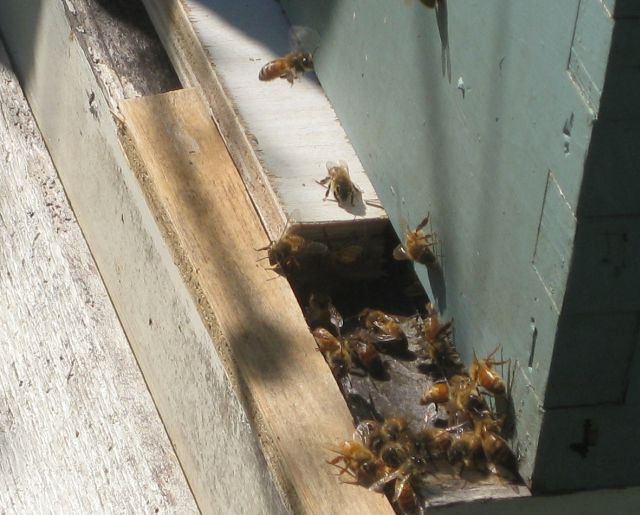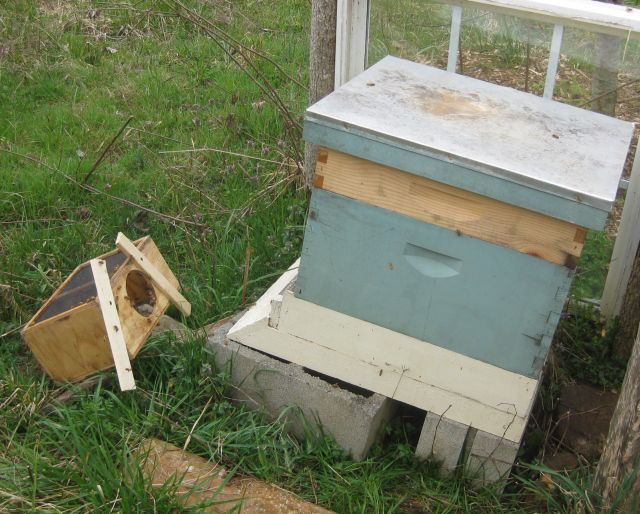I just finished reading “Guns, Germs and Steel” by J. Diamond. A well documented and persuasively argued book with the main conclusion that peoples in different continents and in different areas in the same continent developed differently, not because of race/genetic/biology differences, but because of differences in their physical environments. Food for thought.
Last year I installed 2 packages of bees on the same day in very similar spots. Both had Hawaiian queens. I watched the development of the two hives. One hive had busy bees and from mid-morning to late afternoon they were zipping in and out of their hive. The bees of the second hive were very different – they gathered at the entrance and there seemed little flying activity. They were idled, as with an extended factory tea break. I wondered what caused this difference and concluded they had bad genes, whatever that means. When I harvested honey in late summer there was no surplus honey in the second hive and lots of honey in the first hive. In fall I began feeding (sugared water) both hives so they would have sufficient reserves to make it through the winter. What puzzled me was the second hive appeared to consume the liquid nourishment more voraciously than the first hive. Odd.
Last week I installed 2 packages of bees and followed the same instructions as the previous year – except last year I neglected item 15 “Insert your entrance reducer, leaving a one-finger opening for the bees to defend. Leave the opening in this manner until the bees build up their numbers and can defend a larger hive entrance against intruders.”

And then the penny dropped! My #2 hive last year succumbed to intruders from the get go and this continued throughout the season. Whatever food the #2 hive forager bees brought home was robbed by other bees. Presumably their guard bees were killed off continuously or became demoralized. I remember from high school an explanation of why agriculture collapsed in the Soviet Union. Once the farmers were disenfranchised from their land holdings and had to meet annual production quotas they became disincentivised and production collapsed. This may not longer be the accepted explanation but it made sense to me then and now.
So my theory is #2 hive was continuously raided and they gave up. And this explains why the food I gave them in the fall was consumed so quickly – the hive inhabitants and the marauders from #1 hive were both consuming the food. And quite possibly the honey I harvested from #1 hive included honey stolen from #2 hive.
Which brings me back to “Guns, Germs and Steel”. If the entrance to #2 hive had been reduced in accordance with instructions, then quite likely that hive would have built up strong numbers and thrived. So you could argue that the fate of that hive was determined by its physical environment – no entrance reducer in the early days when it was most needed.
But #1 hive also had no entrance reducer and the foragers of #1 hive attacked and stole the food of #2 hive. So it was more than physical environment – perhaps there were more bees in the #1 package I installed and this made the difference. Or, as I suspect, #1 hive was just a superior hive and its residents overwhelmed the competition.
“Guns, Germs and Steel” posits that the good luck of certain peoples being in good environments was what made the difference. But perhaps those fortunate peoples were not sited in the good environments ab initio. Perhaps even before the development of Guns, Germs and Steel some hunter gatherers or tribes or groupings recognized that some land was better than others – more water, fish, animal, edible vegetation – and defeated the occupants and took control of the better resources.
And if there is some truth in this, then we are back to the old debate of nature vs nurture.

